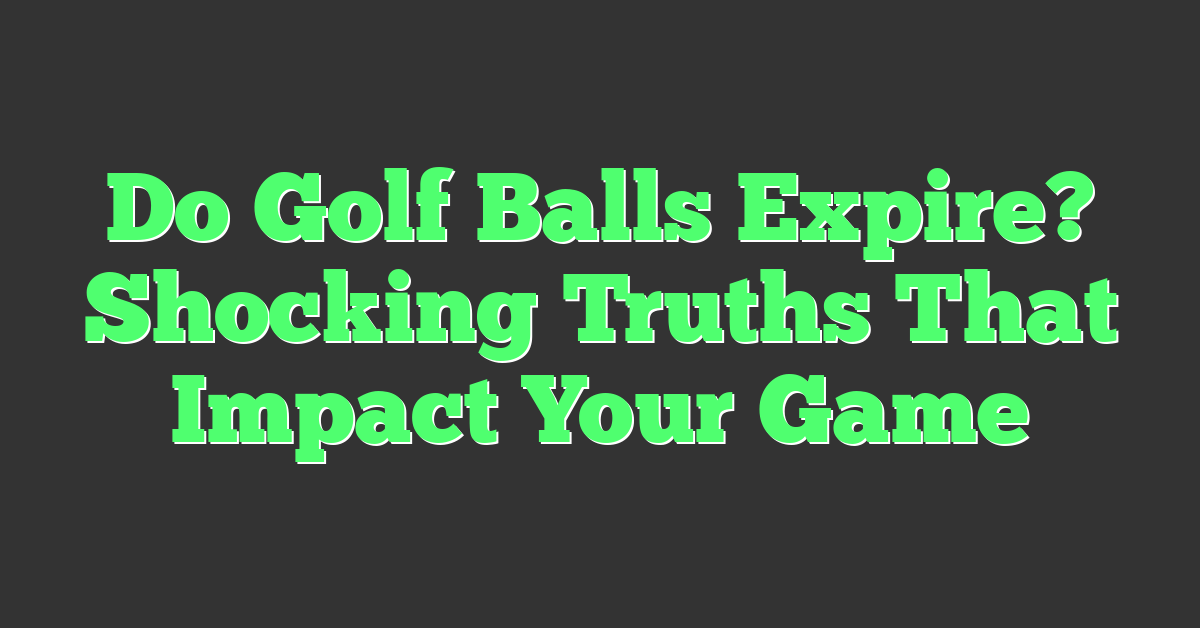Ever wondered if those golf balls tucked away in your garage are still game-ready? Just like a fine wine or your favorite jeans, golf balls have their own aging process. You might not think about the shelf life of your golf gear, but it’s definitely worth a ponder.

You’re out on the green, ready to swing, but pause—could those old golf balls affect your game? It’s a question that’s crossed the mind of many avid golfers. Let’s dive into the lifespan of a golf ball and see if it’s time to refresh your stock.
What Happens When Golf Balls Get Old?
Golf balls, they’re your trusty companions on the course. But as you’ve probably noticed, over time they seem to lose their magic touch. Old golf balls can really throw your game off, but knowing what happens as they age can help you stay on par.
When golf balls get old, their performance starts to deteriorate. It begins with the cover. Made of tough, resilient materials meant to withstand powerful swings, these covers will degrade with exposure to sunlight, moisture, and temperature extremes. As the cover gets rough and scuffed, you’ll notice a decrease in that smooth feel and control you’re used to.
Internally, things get a bit more complex. The core of a golf ball affects spin and speed, and over time, oxidation—that pesky chemical reaction with air—can take its toll. Rubber cores can harden, leading to a drop in the energy transfer from club to ball. In simpler terms, your drives may fall short.
It’s not just about distance either; accuracy can suffer as well. As the materials inside the ball change, so does the balance. An unbalanced ball won’t follow a straight path, making your precise aim for naught.
Here’s what you might experience with old golf balls:
- Less Distance: The harder core contributes to a loss of bounce and carry distance.
- Unpredictable Flight: Imperfections in the cover and core can cause your shot to deviate from the intended line.
- Reduced Spin: If you rely on drawing or fading the ball, the lack of cover grip can diminish these shots.
You’ve worked hard on your swing, so don’t let aged balls cripple your score. Keep an eye on your golf balls’ condition and remember that the shelf life can be affected by factors like how often they’re used and how they’re stored. To keep shaving strokes off your game, rotate your golf balls regularly and treat them with the same care you do your clubs. After all, they’re the only piece of equipment used on every single stroke.
Remember, golf is a game of inches, and the condition of your ball can tip the scales for or against your favor.
Factors That Affect the Lifespan of Golf Balls
When you’re aiming to shave strokes off your game, understanding the factors that can shorten the lifespan of your golf balls is crucial. Just like any piece of equipment, a golf ball isn’t immune to wear and tear, but some elements speed up its aging process.
Exposure to the Elements is a significant factor. Golf balls left outside for extended periods, especially under direct sunlight, are more likely to suffer from the effects of UV radiation. This exposure can lead to the cover’s material breaking down, which impacts the ball’s performance.
Next, consider the Type of Play. If you’re a golfer who loves the challenge of rough terrain or frequently plays on courses with lots of hazards, your golf balls will inevitably take a beating. Scuffs, cuts, and abrasions from cart paths, trees, and rocks can alter the ball’s aerodynamics, making its flight less predictable.
Storage conditions also play a part in the lifespan of your golf balls. Golf balls stored in extreme temperatures—hot or cold—can experience changes in the compression of their core. Ideally, store your balls at room temperature to help maintain their integrity.
Lastly, the Quality of the Golf Ball itself can influence its shelf life. Higher quality balls often have more durable covers and advanced core materials designed to withstand the stresses of repeated play. Investing in a better-grade ball can mean you’ll replace them less frequently, which might be cost-effective in the long run.
Remember, while a seasoned golfer might appreciate the subtle changes in ball performance due to age, if you’re still honing your skills, it’s best to focus on consistent practice with balls that you know are in good condition. Keeping an eye on these factors and rotating your stock will help ensure you’re always playing with a ball that’s up to par.
Signs of Aging in Golf Balls
As you strive to hone your skills and lower your handicap, understanding the subtle signs of aging in your golf balls is crucial. A ball past its prime not only deviates from its intended flight path but can also undermine your well-practiced swings.
Discoloration is a telltale sign. Over time, golf balls may yellow or fade, particularly if they’ve been left out in the sun. This isn’t just an aesthetic issue; it’s an indicator that the cover material is degrading due to UV exposure.
Loss of the original sheen is another red flag. Fresh out of the box, golf balls are glossy and smooth, but with usage and exposure, they can lose that lustre. It’s a hint that the cover could be compromised, affecting the ball’s aerodynamics.
When you’re out on the course, pay attention to how your ball reacts upon impact. A ball that has lost its firmness will often feel different when struck – a muted, less responsive sensation on contact hints at core degradation, which can impact the distance and accuracy.
Another clear indicator is visible damage, such as cuts and scuffs on the ball’s surface. While these can result from a particularly aggressive shot or encounter with the course’s rougher features, they’re also symptoms of the cover’s wear and tear. Such imperfections can alter the ball’s flight, reducing your ability to predict and control where it’ll land.

Check the consistency of ball flight and backspin. As golf balls age, their performance becomes less reliable. You might notice that shots you’ve executed flawlessly hundreds of times before are now veering off course or not stopping on the green as quickly as they used to.
- Maintain a rotation in your ball stock
- Regularly inspect your golf balls for signs of aging
- Replace older balls with new ones when performance starts to wane
Remember, identifying aging golf balls is part of the game’s strategy. Keeping your equipment in top condition is just as important as perfecting your swing or mastering course management. Your attention to these details can shave strokes off your game, driving you closer to your best scores yet.
How Long Do Golf Balls Last?
As a seasoned golfer, you’re always striving to nudge your scores lower and understanding equipment is a crucial part of that quest. One question that’s bound to pop up is how long those trusty golf balls last before they need replacing.
A golf ball’s lifespan isn’t infinite, and certainly, quality and usage dictate longevity. A standard golf ball can last anywhere from 5 rounds to a full season if you’re not losing too many to the hazards. However, that’s assuming you’re playing with one ball per round, which isn’t always the case, especially if you’re out there practicing often.
If you’re a golfer who spends a good chunk of time on the course, your golf balls will see a lot of action. They endure repeated high-speed impacts, which starts to wear down the materials. For you, playing with the same ball over multiple rounds and practice sessions, the wear and tears can shorten a ball’s life to mere weeks.

Caring for your golf balls is an important part of extending their usability. Keeping them clean and storing them at room temperature ensures the materials don’t degrade prematurely. Avoid leaving them in your car, especially on hot days, as extreme temperatures can affect the rubber components inside the ball, altering their performance.
Let’s look at some numbers to get a clearer picture of a golf ball’s lifespan:
| Rounds Played | Expected Lifespan |
|---|---|
| 1-5 Rounds | Up to a full season |
| 6-10 Rounds | Several months to half a season |
| 10+ Rounds | Few weeks to a month |
Bear in mind that these numbers are based on typical scenarios and don’t account for external factors like storage conditions and the type of course you’re playing on. Golf balls can also last for decades when kept as collectibles or souvenirs, as long as they’re not used in play.
By keeping a keen eye on your golf balls and understanding their life expectancy, you’re one step closer to fine-tuning your game. And as you wouldn’t want the condition of your ball to impact those precious strokes, make sure you’re rotating your stock to get the best performance for each shot.
How Aging Golf Balls Impact Your Game
Ever wondered why that once trusty golf ball doesn’t seem to soar down the fairway as it used to? As you hone your skills on the green, don’t overlook the aging process of your golf balls and how it can affect your game. Performance decline in an older ball can sneak up on you, and understanding the signs can save you strokes.

An aging golf ball can exhibit reduced elasticity. That crisp compression upon contact with the club? It doesn’t happen the same way with an old ball. When the core of the golf ball becomes less responsive, you’re left with a loss of distance. This means your swing has to work overtime to cover the yardage you once easily achieved. If you’re playing a par 4 and suddenly find yourself struggling to reach the green in two, consider whether your golf balls might be past their prime.
Additionally, the control you expect during your short game might take a hit. Old golf balls can develop small imperfections on their surface, leading to unpredictable flight behavior and an increased chance of errant shots. And let’s not forget spin degradation; those meticulous attempts to stick the greens may fall short as the ball’s ability to grip the turf diminishes.
It’s not just about the external factors, either. Internal damages can occur without visible signs. Moisture and temperature fluctuations can compromise the integrity of the ball from the inside out. You might not see it, but you’ll feel it in a ball’s dulled reaction to your trusty wedge.
To stay ahead, inspect your golf balls regularly for any abnormalities or changes in performance. While it’s true that a seasoned golfer can make do with less-than-perfect equipment, you don’t need to handicap your game unnecessarily. Keep track of how your balls respond during practice rounds and replace them when you sense performance faltering. After all, every stroke counts.










